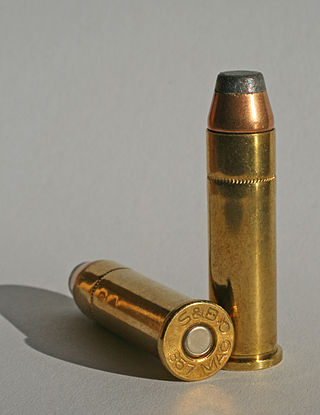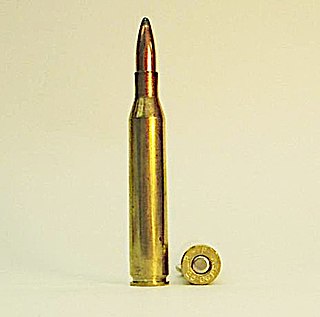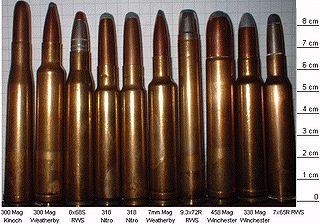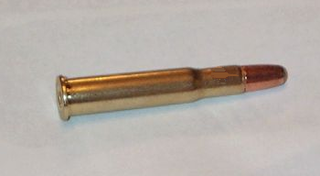Handloading, or reloading, is the practice of making firearm cartridges by assembling the individual components, rather than purchasing mass-assembled, factory-loaded ammunition.

A cartridge, also known as a round, is a type of pre-assembled firearm ammunition packaging a projectile, a propellant substance and an ignition device (primer) within a metallic, paper, or plastic case that is precisely made to fit within the barrel chamber of a breechloading gun, for convenient transportation and handling during shooting. Although in popular usage the term "bullet" is often used to refer to a complete cartridge, the correct usage only refers to the projectile.

The .38 Special, also commonly known as .38 S&W Special, .38 Smith & Wesson Special, .38 Spl, .38 Spc, or 9x29mmR is a rimmed, centerfire cartridge designed by Smith & Wesson.

A centerfire cartridge is a firearm metallic cartridge whose primer is located at the center of the base of its casing. Unlike rimfire cartridges, the centerfire primer is typically a separate component seated into a recessed cavity in the case head and is replaceable by reloading.

The .357 Smith & Wesson Magnum, .357 S&W Magnum, .357 Magnum, or 9×33mmR is a smokeless powder cartridge with a 0.357 in (9.07 mm) bullet diameter. It was created by Elmer Keith, Phillip B. Sharpe, and Douglas B. Wesson of firearm manufacturers Smith & Wesson and Winchester. The .357 Magnum cartridge is notable for its highly effective terminal ballistics.

Smokeless powder, also referred to as gunpowder, is a type of propellant used in firearms and artillery that produces less smoke and less fouling when fired compared to black powder. The combustion products are mainly gaseous, compared to around 55% solid products for black powder. In addition, smokeless powder does not leave the thick, heavy fouling of hygroscopic material associated with black powder that causes rusting of the barrel.

The .223 Remington is a rimless, bottlenecked, centerfire rifle cartridge. It was developed in 1957 by Remington Arms and Fairchild Industries for the U.S. Continental Army Command of the United States Army as part of a project to create a small-caliber, high-velocity firearm. The .223 Remington is considered one of the most popular common-use cartridges and is currently used by a wide range of semi-automatic and manual-action rifles.
The .30-06 Springfield cartridge, 7.62×63mm in metric notation, and called the .30 Gov't '06 by Winchester, was introduced to the United States Army in 1906 and later standardized; it remained in military use until the late 1970s. In the cartridge's name, ".30" refers to the nominal caliber of the bullet in inches; "06" refers to the year the cartridge was adopted, 1906. It replaced the .30-03 Springfield, 6mm Lee Navy, and .30-40 Krag cartridges. The .30-06 remained the U.S. Army's primary rifle and machine gun cartridge for nearly 50 years before being replaced by the 7.62×51mm NATO and 5.56×45mm NATO, both of which remain in current U.S. and NATO service. The cartridge remains a very popular sporting round, with ammunition produced by all major manufacturers.

Considered by many as the most balanced of the "quarter bores" for hunting medium-sized game, the .25-06 Remington remained in obscurity as a wildcat cartridge for nearly half a century before being standardized by Remington in 1969.

The .458 Winchester Magnum is a belted, straight-taper cased, Big Five game rifle cartridge. It was introduced commercially in 1956 by Winchester and first chambered in the Winchester Model 70 African rifle. It was designed to compete against the .450 Nitro Express and the .470 Nitro Express cartridges used in big bore British double rifles. The .458 Winchester Magnum remains one of the most popular large game cartridges, and most major ammunition manufacturers offer a selection of .458 ammunition.

The .30-30 Winchester cartridge was first marketed for the Winchester Model 1894 lever-action rifle in 1895. The .30-30, as it is most commonly known, along with the .25-35 Winchester, was offered that year as the United States' first small-bore sporting rifle cartridges designed for smokeless powder. Since its introduction, it has been utilized alongside the development of flatter shooting cartridges, most prominently those derived from designs subsidized by interest in military expenditures, yet the .30-30 has remained in widespread use almost entirely because of reliable effectiveness in civilian applications, proven by putting food on the table for millions of people within a practical range of hunting situations.

The 7.5×55mm Swiss or 7,5mm GP 11 is a cartridge developed for the Swiss Army. It originated from the Gewehrpatrone 1890 (7.5×53.5mm) developed in 1898 by mechanical engineer Lt. Col. Eduard Rubin for rifles based on Rudolf Schmidt's action design. The 7.5×55mm Swiss GP 11 cartridge is similar in appearance to the slightly smaller 7.5×54mm French round though the two are not interchangeable.

A black powder substitute or gunpowder substitute is a replacement for black powder (gunpowder) used in muzzleloading and cartridge firearms. Black powder substitutes have slightly different properties from gunpowder and are subject to different restrictions. Compared to gunpowder, black powder substitutes may have reduced sensitivity as an explosive, increased efficiency as a propellant powder, different density, and/or reduced ignition efficiency.

The Hodgdon Powder Company began in 1952 as B.E. Hodgdon, Inc., and has become a major distributor of smokeless powder for the ammunition industry, as well as for individuals who load their own ammunition by hand. The company's corporate office and manufacturing facilities are located in Kansas, United States. Hodgdon acquired IMR Powder Company in 2003. Winchester branded reloading powders have been distributed in the United States by Hodgdon since March 2006.

The .275 Holland & Holland Magnum is a semi-obsolete rifle cartridge similar to the 7mm Remington Magnum. Essentially the .275 Holland & Holland Magnum is a necked down shortened variant of the .375 Holland & Holland Magnum. It was introduced by the British company Holland & Holland with the .375 Holland & Holland Magnum that was introduced in 1912 as the .375 Belted Rimless Nitro-Express. The .375 Holland & Holland Magnum was intended for dangerous African game animals, while the .275 Holland & Holland Magnum was intended for longer range shooting of antelope in Africa and Red Stag in the highlands of Scotland.
The .276 Enfield (7×60mm) was an experimental rebated rim bottlenecked centerfire military rifle cartridge developed in conjunction with the Pattern 1913 Enfield (P'13) rifle. Development was discontinued by the onset of World War I.
Ball propellant is a form of nitrocellulose used in small arms cartridges. Ball propellant can be manufactured more rapidly with greater safety and less expense than extruded propellants.

The .45-75 WinchesterCentennial is a centerfire rifle cartridge developed in 1876 for the newly designed Winchester Model 1876 Centennial lever-action rifle. Winchester Repeating Arms Company introduced the rifle and cartridge at the United States Centennial Exposition. The Model 1876 rifle used an enlarged version of the famous Winchester Model 1873 action to offer a lever-action repeating rifle using cartridges suitable for big-game hunting. The cartridge and rifle enjoyed brief popularity with Gilded Age American hunters including Theodore Roosevelt, and was issued to the Canadian North-West Mounted Police and to Texas Rangers.

IMR Legendary Powders is a line of smokeless powders which are popularly used in sporting and military/police firearm cartridges. The initials 'IMR' stand for Improved Military Rifle powder. IMR powders makes a line of various types of smokeless powder suitable for loading many cartridges for rifles, handguns, and shotguns.

A powder measure is a device for dispensing consistent amounts of smokeless powder or black powder as charges for handloading cartridges used as small arms ammunition.
















